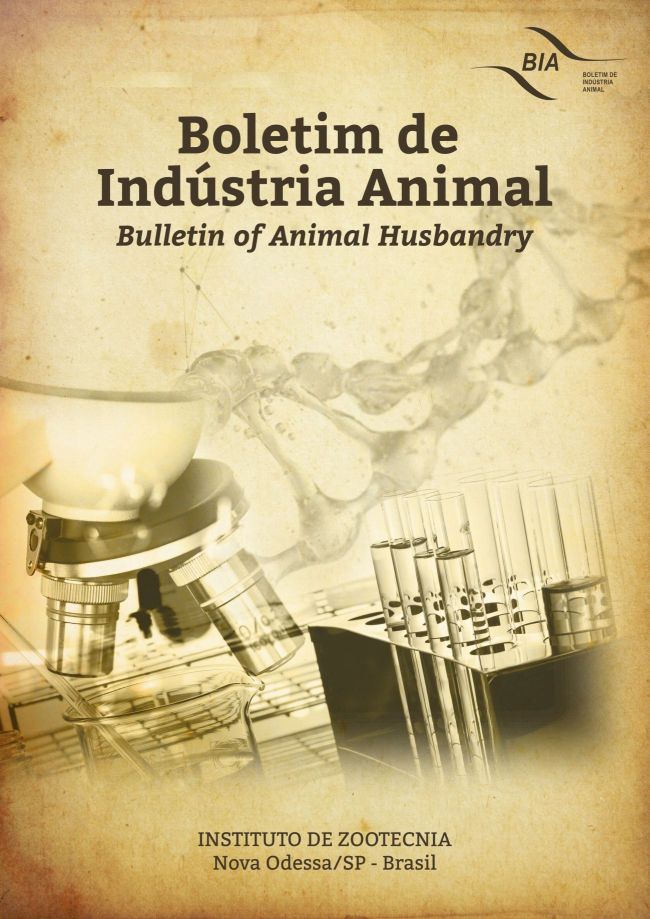Replacement of vit D3 by metabolite of vegetable origin 1,25(oh)2d3 influencing performance and bone quality in broilers at 21 days of age
DOI:
https://doi.org/10.17523/bia.2019.v76.e1445Keywords:
bone calcium, bone strength, Solanum glaucophylum, D vitaminAbstract
The objective of this study was to evaluate the inclusion of 1.25(OH)2D3 as a substitute of vitamin D3 (cholecalciferol) in the vitamin supplement of broiler diets, as well as the influence of this metabolite on performance and bone quality up to 21 days of age. A total of 1.400 male chicks were used. At 7 days of age, the animals were weighed and divided into six experimental treatments, with 6 replicates and 38 birds per replicate. The treatments consisted of maintaining the amount of vitamin D3 for broilers at 100%, 75%, 50%, 25% and 0% plus the addition of a fixed quantity of bioactive vitamin metabolite [1,25(OH)2D3]. As the control treatment, the animals received only vitamin D3 at the recommended dose as the sole source of vitamin D. Data were submitted to analysis of variance using the General Linear Models procedure of the SAS® software. In the case of statistically significant differences, means were compared by the Dunnett test at 5% probability. The mean weight, weight gain and daily weight gain differed significantly (p<0.05) from the control by the Dunnett test only for the treatment with inclusion of 75% vitamin D3+1.25 (OH)2D3, with better averages for these variables. Feed intake was higher (p<0.05) in chickens receiving 25% vitamin D3+1.25(OH)2D3 when compared to birds fed the control diet. The worst €‹€‹(p<0.05) mean weight, weight gain, daily weight gain and feed intake were observed when 1.25(OH)2D3 was included as a single source of vitamin D3, with no significant difference (p>0.05) in feed conversion. Bone morphometry was not influenced (p>0.05) by the reduction of vitamin D3 in the vitamin supplement nor by the use of 1.25(OH)2D3. The calcium percentage in tibia ashes was higher (p<0.05) for the treatment with 75% vitamin D3+1.25(OH)2D3 inclusion compared to control by the Dunnett test. The reduction of vitamin D3 up to 25% of the required level in the vitamin supplement, combined with the inclusion of 50 g 1.25(OH)2D3/ton of ration, allows to maintain the performance and bone quality of broilers at 21 days of age. The use of 1.25(OH)2D3 as a single source of vitamin D at the amount tested compromised performance and worsened bone quality as assessed by ash percentage and bone resistance to fracture.
Downloads
Downloads
Published
Issue
Section
License
Os autores não serão remunerados pela publicação de trabalhos, pois devem abrir mão de seus direitos autorais em favor deste periódico. Por outro lado, os autores ficam autorizados a publicar seus artigos, simultaneamente, em repositórios da instituição de sua origem, desde que citada a fonte da publicação original seja Boletim de Indústria Animal. A revista se reserva o direito de efetuar, nos originais, alterações de ordem normativa, ortográfica e gramatical, com vistas a manter o padrão culto da língua e a credibilidade do veículo. Respeitará, no entanto, o estilo de escrever dos autores. Alterações, correções ou sugestões de ordem conceitual serão encaminhadas aos autores, quando necessário. Nesses casos, os artigos, depois de adequados, deverão ser submetidos a nova apreciação. As opiniões emitidas pelos autores dos artigos são de sua exclusiva responsabilidade. Todo o conteúdo deste periódico, exceto onde está identificado, está licenciado sob a Licença Creative Commons Attribution (CC-BY-NC). A condição BY implica que os licenciados podem copiar, distribuir, exibir e executar a obra e fazer trabalhos derivados com base em que só se dão o autor ou licenciante os créditos na forma especificada por estes. A cláusula NC significa que os licenciados podem copiar, distribuir, exibir e executar a obra e fazer trabalhos derivados com base apenas para fins não comerciais.













